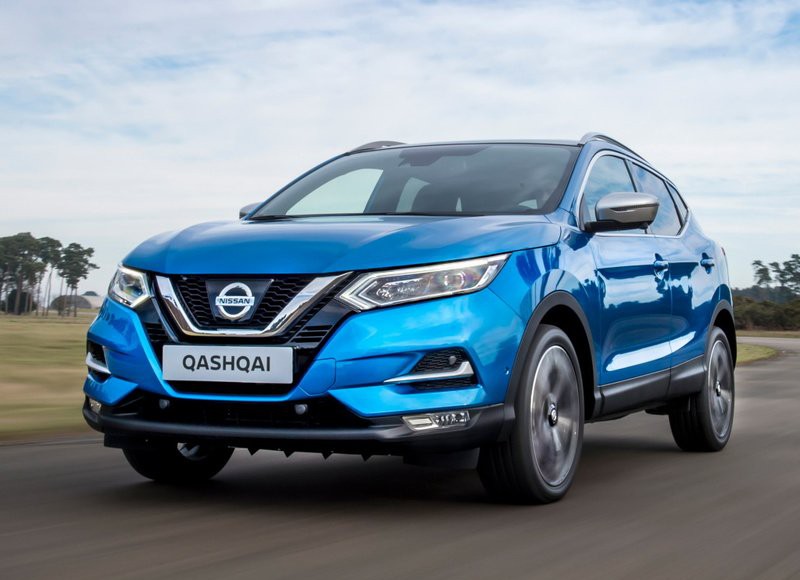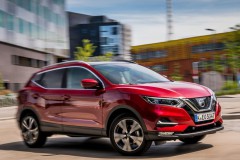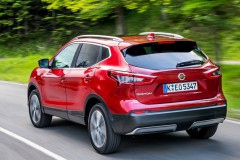Nissan Qashqai 2017 J11
For me, a flawless car, both technically and visually. I like the big, attractive steering wheel. The new Qashqai seems to have improved driveability thanks to Nissan's ride control system. The car body shakes less on rough roads when compared to the older models. Like lots of other things too - 360 camera, self-dimming mirror, split climate control, extreme braking.
read all Nissan Qashqai reviews
This generation of Nissan Qashqai J11 (facelift model) has been produced from 2017 to 2021. We can provide information about 15 modifications of this generation. 2017 Nissan Qashqai is available with four wheel (4x4) drive (3 versions) and front wheel drive (12 versions). Four wheel drive models have AWD (all wheel drive) system (power is automatically distributed between the wheel axles).
This Nissan is available with four petrol engines with displacement from 1.2 to 1.6 litres and power of from 115 to 163 horsepower un four diesel engines with displacement from 1.5 to 1.7 litres and power of from 110 to 150 horsepower.
The car is available with both manual (10 versions), as well as automatic (5 versions) gearbox.
Nissan Qashqai 2017 J11 average fuel consumption in combined cycle for petrol engine is from 5.6 to 5.8 litres per 100km, whereas for diesel engine - from 3.8 to 4.9 litres per 100km. The most fuel efficient Nissan Qashqai 2017 J11 petrol engine version is Nissan Qashqai 1.2, consuming 5.6 litres per 100km. While the most fuel efficient Nissan Qashqai 2017 J11 diesel - Nissan Qashqai 1.5 dci for 100 kilometers consumes 3.8 liters of diesel.
According to user reviews, Nissan Qashqai real-world fuel consumption is on average about approximately for 37 percents higher as the manufacturer's claimed fuel economy (on average +38% for petrol engines and +35% for diesel engines). For a more detailed actual fuel economy of each model, select a specific Nissan Qashqai modification.
Nissan Qashqai 2017 J11 CO2 emissions for petrol engine are from 129 to 134 grams per kilometer, whereas for diesel engine - from 99 to 129 grams per kilometer. From Nissan Qashqai with petrol engines the lowest CO2 emissions has Nissan Qashqai 1.2 which produces an average of 129 grams of CO2 per kilometer. In turn, from the Nissan Qashqai diesels least CO2 distributes Nissan Qashqai 1.5 dci - 99 grams per km.
The best acceleration from 0 to 100 km/h - 8.9 seconds has Nissan Qashqai 1.6 version, conversely the tardiest one is Nissan Qashqai 1.5 dCi Automatic reaching this speed only in 13 seconds. The maximum top speed is 200 km/h for the 1.3 petrol 4-cylinder 160 hp version (Nissan Qashqai 1.3i 160 Hp) and the 1.6 petrol 4-cylinder 163 hp version (Nissan Qashqai 1.6).
Lenght of Nissan Qashqai is 439 cm, it is medium size car. Nissan Qashqai gross weight is from 1860 to 2110 kg (depending on modification), which is about 7 percent lighter than the average for this age and class. Nissan Qashqai trunk space is 430 litres, by folding down all rear seats boot capacity can be increased to 1598 litres.
This Nissan is relatively cheap - it can be purchased (in Latvia, EU) for around 14 500 €. Below you will find more detailed information about Nissan Qashqai prices and costs.
Nissan Qashqai modifications
| Modification | Engine | Power | Consumption | Gearbox | Drive type |
|---|---|---|---|---|---|
|
Nissan Qashqai 2017 1.2
Jan 2017 — Dec 2018 Most fuel efficient petrol version |
1.2 Petrol | 115 HP | 5.6 l/100km | Manual (6) | Front wheel |
|
Nissan Qashqai 2017 1.2 Automatic
Jan 2017 — Dec 2018 Most fuel efficient petrol version |
1.2 Petrol | 115 HP | 5.6 l/100km | Automatic | Front wheel |
| Nissan Qashqai 2018 1.3i 140 Hp Jan 2018 — Dec 2021 | 1.3 Petrol | 140 HP | - | Manual (6) | Front wheel |
|
Nissan Qashqai 2018 1.3i 160 Hp
Jan 2018 — Dec 2021 Most dynamic version - 100 km/h in 8.9 seconds |
1.3 Petrol | 160 HP | - | Manual (6) | Front wheel |
| Nissan Qashqai 2018 1.3i 160 Hp Automatic Jan 2018 — Dec 2021 | 1.3 Petrol | 160 HP | - | Automatic (7) | Front wheel |
|
Nissan Qashqai 2017 1.5 dci
Jan 2017 — Dec 2018 Most fuel efficient diesel version |
1.5 Diesel | 110 HP | 3.8 l/100km | Manual (6) | Front wheel |
|
Nissan Qashqai 2018 1.5 dCi
Jan 2018 — Dec 2020 Most fuel efficient diesel version by real consumption |
1.5 Diesel | 115 HP | - | Manual (6) | Front wheel |
| Nissan Qashqai 2019 1.5 dCi Automatic Jan 2019 — Dec 2020 | 1.5 Diesel | 115 HP | 4.4 l/100km | Automatic (7) | Front wheel |
|
Nissan Qashqai 2017 1.6
Jan 2017 — Dec 2018 Most dynamic version - 100 km/h in 8.9 seconds |
1.6 Petrol | 163 HP | 5.8 l/100km | Manual (6) | Front wheel |
| Nissan Qashqai 2017 1.6 dci Jan 2017 — Dec 2018 | 1.6 Diesel | 130 HP | 4.4 l/100km | Manual (6) | Front wheel |
| Nissan Qashqai 2017 1.6 dci Automatic Jan 2017 — Dec 2018 | 1.6 Diesel | 130 HP | 4.7 l/100km | Automatic | Front wheel |
| Nissan Qashqai 2017 1.6 dci 4x4 Jan 2017 — Dec 2018 | 1.6 Diesel | 130 HP | 4.9 l/100km | Manual (6) | All wheel |
| Nissan Qashqai 2019 1.7 dCi Jan 2019 — Dec 2020 | 1.7 Diesel | 150 HP | - | Manual (6) | Front wheel |
| Nissan Qashqai 2019 1.7 dCi 4x4 Jan 2019 — Dec 2020 | 1.7 Diesel | 150 HP | - | Manual (6) | All wheel |
| Nissan Qashqai 2019 1.7 dCi Automatic 4x4 Jan 2019 — Dec 2020 | 1.7 Diesel | 150 HP | - | Automatic | All wheel |
Useful information
Nissan Qashqai prices
Nissan Qashqai 2017 - 2021 crossover price in Latvia is from 8500 € to 22500 €.
Comparing to analogical vehicles Nissan Qashqai price is more below average - Nissan Qashqai is approximately for 28 percents cheaper then average crossovers of this age (compare crossovers 2017 - 2021 prices).
| Year | Lowest | Average | Highest | Availability |
|---|---|---|---|---|
| Nissan Qashqai 2021 price | 16 000 € | 19 500 € | 22 500 € | |
| Nissan Qashqai 2020 price | 13 000 € | 16 000 € | 17 500 € | |
| Nissan Qashqai 2019 price | 11 000 € | 14 000 € | 16 500 € | |
| Nissan Qashqai 2018 price | 11 000 € | 12 500 € | 15 000 € | |
| Nissan Qashqai 2017 price | 8500 € | 10 000 € | 12 000 € |
Nissan Qashqai total costs of ownership
How much really costs to own Nissan Qashqai?
Nissan Qashqai 2017 total costs of ownership calculator
Calculate total cost of ownership of the Nissan Qashqai, including purchase, insurance, maintenance, taxes and other costs based on how you use your vehicle.
Nissan Qashqai mileage
To estimate approximate Nissan Qashqai mileage, please choose production year
2017 2018 2019 2020 2021

Check Vehicle's History
Access 300+ million damage records from 900+ data sources across 40+ countries.
Get 20% off your VIN check using this form!
Nissan Qashqai reliability and quality
According to yearly reports of vehicle inspection service Nissan Qashqai reliability is average. In the roadworthiness tests in 2022 defects were detected in an average of 5.3 percent of Nissan Qashqai of this generation (on average 3 years old at the time of inspection). The average failure rate for a vehicles of the same age was 5.9%.
Nissan Qashqai reliability and quality
Most reliable 7-9 year old used cars
Most reliable 7-9 year old used crossovers
Nissan Qashqai 2017 J11 features (options)
Percentage of Nissan Qashqai with corresponding feature (option)
86% Climate control
83% Rain sensor
83% Conditioning
76% Metallic paint
63% Distance control
39% Xenon headlights
19%
Nissan Qashqai 2017 J11 photo images
Similar cars to Nissan Qashqai 2017
Cars similar and most compared to Nissan Qashqai 2017. Click on the image to view the car's specifications or on the "Compare..." link to compare cars.
- fewer faults
- higher ground clearance
- roomier boot
- roomier boot
- roomier boot
- petrol, diesel and hybrid engines available
- fewer faults
- lower price
- higher ground clearance
- fewer faults
- roomier boot
Nissan Qashqai reviews
Total 37 Nissan Qashqai owner reviews
Pros: For me, a flawless car, both technically and visually. I like the big, attractive steering wheel. The new Qashqai seems to have improved driveability thanks to Nissan's ride control system. The car body shakes less on rough roads when compared to the older models. Like lots of other things too - 360 camera, self-dimming mirror, split climate control, extreme braking.
Cons: As for the car's fuel consumption - as far as I understand, in the past the fuel consumption per 100km factory was determined by the NEDC protocol, which was basically the number that represents the lowest possible fuel consumption for your car. Now the new models sold are with the WLTP protocol, which has been measured in a wide variety of real-world usage conditions and can be said to be an average but much more realistic figure. I just want to say that blaming the factory doesn't make sense, but you have to try, test your own driving style and circumstances.
| Purchase year: | 2018 new car) | Owned for | 18`000 kilometers (1 year) |
|---|---|---|---|
| Average fuel consumption: | 4.9 litres per 100km (80% urban driving) | ||
Would recomend this car to the friend










